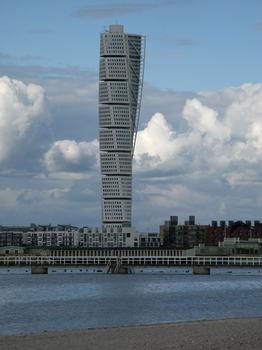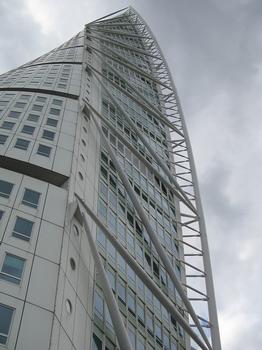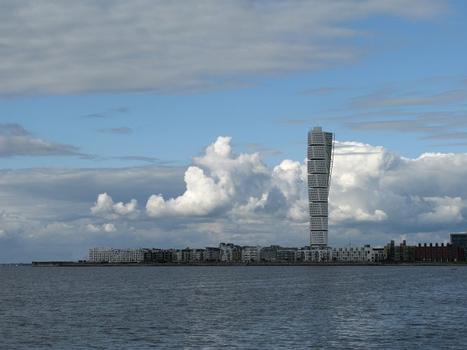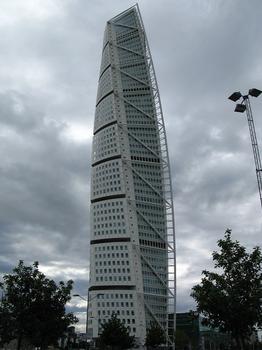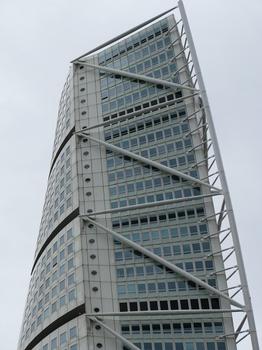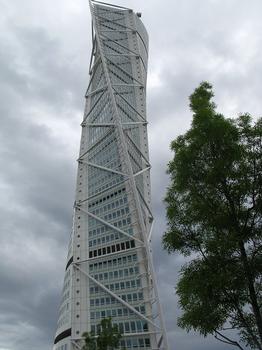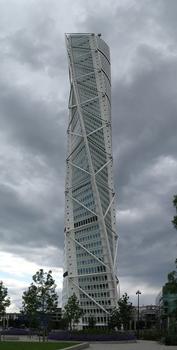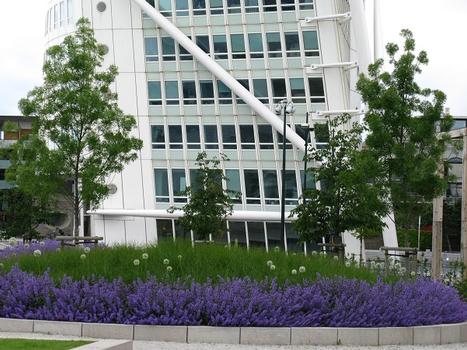General Information
Project Type
| Function / usage: |
Office building Apartment building |
|---|---|
| Architectural style: |
Neo-futurist |
Awards and Distinctions
| 2015 |
award winner
for registered users |
|---|---|
| 2006 |
award winner
for registered users |
Location
| Location: |
Malmö, Skåne län, Sweden |
|---|---|
| Address: | Västra Varvsgatan 34 |
| Near: |
Turning Torso Gallery
|
| Coordinates: | 55° 36' 48" N 12° 58' 34" E |
Technical Information
Dimensions
| height | 190 m | |
| number of floors (above ground) | 54 |
Excerpt from Wikipedia
Turning Torso is a neo-futurist residential skyscraper in Sweden and the tallest building in Scandinavia.
Located in Malmö on the Swedish side of the Öresund strait, it was built and is owned by Swedish cooperative association HSB. It is regarded as the first twisted skyscraper in the world.
The project was designed by Spanish architect, structural engineer, sculptor and painter Santiago Calatrava and officially opened on 27 August 2005. The tower reaches a height of 190 metres (623 ft) with 54 stories and 147 apartments.
In August 2015, it was announced that the building was the winner of the 10 Year Award from the Council on Tall Buildings and Urban Habitat. It won the 2005 Gold Emporis Skyscraper Award.
Design
Turning Torso is based on a sculpture by Calatrava, called Twisting Torso, which is a white marble piece based on the form of a twisting human being. It is the first "twisting" tower.
In 1999, HSB Malmö's former managing director, Johnny Örbäck, saw the sculpture in a brochure presenting Calatrava in connection with his contribution to the architectural competition for the Öresund Bridge. It was on this occasion that Örbäck was inspired to build HSB Turning Torso. Shortly afterwards he travelled to Zurich to meet Calatrava, and ask him to design a residential building based on the idea of a structure of twisting cubes.
Illustration of the general structure of the Turning Torso. (1) shows a typical floor plan, where the grey circle denotes the core and blue shapes denote the steel framework. (2) shows the way the nine segments fit around the core, and (3) is a diametric projection of the tower.
This is a solid immobile building constructed in nine segments of five-storey pentagons that twist relative to each other as it rises; the topmost segment is twisted 90 degrees clockwise with respect to the ground floor. Each floor consists of an irregular pentagonal shape rotating around the vertical core, which is supported by an exterior steel framework. The two bottom segments are intended as office space. Segments three to nine house 147 apartments.
Construction
Construction started in the summer of 2001. One reason for building Turning Torso was to re-establish a recognisable skyline for Malmö since the removal in 2002 of the Kockums Crane, which was located less than one kilometre (0.62 mi) from Turning Torso. The local politicians deemed it important for the inhabitants to have a new symbol for Malmö in lieu of the crane that had been used for shipbuilding and somewhat symbolised the city's blue collar roots.
The construction of part of this building was featured on Discovery Channel Extreme Engineering TV programme which showed how a floor of the building was constructed.
Prior to the construction of Turning Torso, the 86-metre (282 ft) Kronprinsen had been the city's tallest building.
The apartments were initially supposed to be sold, but insufficient interest resulted in the apartments being let. The owner has several times unsuccessfully tried to sell the building. The construction costs were almost double the estimate.
Text imported from Wikipedia article "Turning Torso" and modified on July 22, 2019 according to the CC-BY-SA 4.0 International license.
Participants
Relevant Web Sites
Relevant Publications
- : Calatrava recibe en Cannes el premio al mejor edificio de viviendas por su Turning Torso. In: El País, 12.03.2005.
- (2018): Deconstructing the 'Formula One of Housing': Screen Representations of Malmö's Turning Torso. In: Built Environment, v. 43, n. 4 (January 2018), pp. 604-619.
- (2008): Edificio Turning Torso en Malmo (Suecia). Presented at: IV Congreso de la Asociación Científico-Tecnica del Hormigón Estructural - Congreso Internacional de Estructuras, Valencia, 24-27.11.2008.
- (2008): Skyscrapers. A History of the World's Most Extraordinary Buildings. 2nd edition, Black Dog & Leventhal Publishers, Inc., New York (USA), ISBN 978-1-57912-787-9, pp. 130-131.
- About this
data sheet - Structure-ID
20003317 - Published on:
20/05/2002 - Last updated on:
26/02/2016

